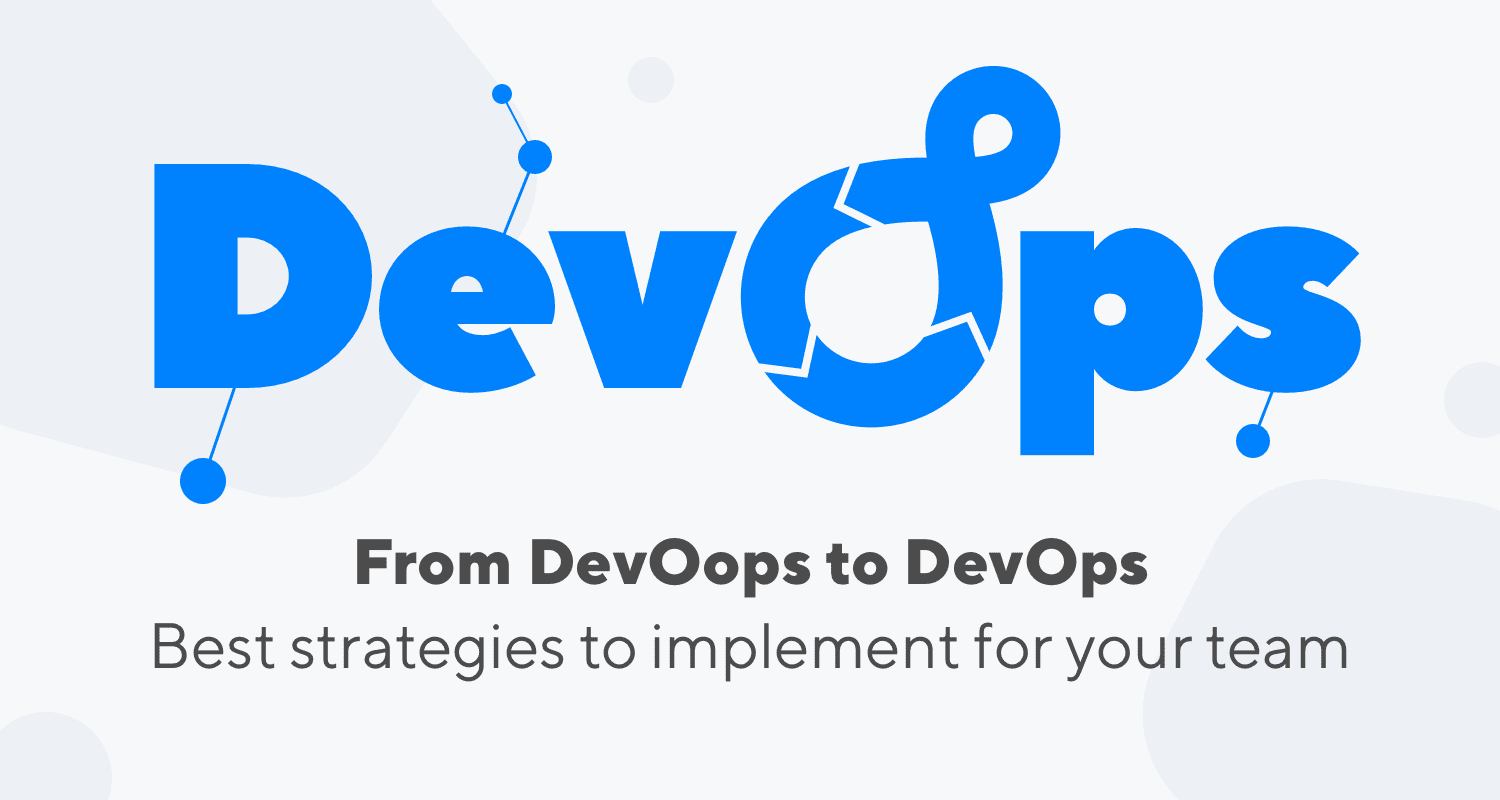
From DevOops to DevOps: 6 Strategies for Successful DevOps Transformation

In today’s rapidly changing world, software products need to be upgraded frequently and quickly in order to bring value to customers and users.
As a result, software features are continuously developed, tested, deployed, and operated in the production environment.
It is essential that new features are not only developed and tested successfully but are also deployed and operated without much chaos or disruption. Cross-functional software teams, which include product owners, software development, quality assurance (QA), and operations, need to work together to ensure the fast flow of work from development to operation. This requires development teams to be more productive in delivering quality work and QA, operations, and other teams to use automated tools and follow well-formed practices to minimize their dependence on other teams. DevOps, a well-known software development practice, is the process that organizations seek to achieve this goal.
This blog shares six essential DevOps implementation strategies for organizations to follow to support a successful DevOps transformation effort.
Organizational change
A transformation in DevOps must begin from within. It involves organizing, empowering, and enabling teams to maximize their capabilities and their chances of success. In other words, it is more about people than tools and technology.
Organizations need to establish and nourish a DevOps culture that encourages continuous learning, cross-team collaboration, team empowerment, and sharing metrics as a way for continuous improvement. Such a DevOps culture can span multiple teams across departments.
To be effective, a dedicated team should be formed and be responsible for the DevOps transformation effort for the whole organization. Ideally, this team is a separate entity from the rest of the company and focuses solely on the daily operations with the freedom and support to innovate and think outside of the box. Objectives and goals for the team must be clear, specific, achievable, and measurable, and be agreed upon by executives and shared with everyone. Members of the team should dedicate their full attention to the transformation effort and possess skills in different domains across the organization, such as information security (InfoSec), development, operations, sales, and marketing.
Start with the right team
To start a DevOps transformation effort, it is important, to begin with selecting the right project or initiative. Applying DevOps to a new project tends to be easier than existing ones because you don’t have to deal with existing codebases, processes, and teams. Making changes to existing projects is riskier when they have current products or services in operation. However, many DevOps transformation efforts begin with existing projects in order to address ongoing problems in the development and operations of the related products or services. In fact, according to a 2015 State of DevOps report, high performance in IT organizations deploying DevOps is achievable in both new (brownfield) and existing (greenfield) applications.
After honing in on the right project, you should consider choosing the most innovative, energetic, and sympathetic teams to start with as their members tend to welcome and adopt new ideas. Correspondingly, a team that has influence and respect from the organization is also a good candidate. A team’s success in DevOps transformation offers a testament and makes the process of expanding the effort to other teams easier.
After choosing a team to work with for your DevOps initiative, it’s important to evaluate member knowledge and skills as it relates to DevOps. In order to ensure success and prevent roadblocks, be prepared to hire experts and provide sufficient staff training on DevOps processes, practices, and tools.
Establish a continuous integration and delivery (CI/CD) pipeline
Organizations must establish and implement the practices necessary for the continuous flow of work from development to operations. A set of such practices forms a CI/CD pipeline, designed to ensure the fast and reliable delivery of work from development to operations without causing problems in the production.
At every stage of the CI/CD pipeline, production-line environments should be used. Development, testing, and staging environments must mirror production in order to eliminate a potential mismatch between development and operations. When a problem occurs in operations, developers can quickly detect and fix it without interfering with the normal operation of the system.
Environments should be created automatically using scripts and predefined configurations. This practice allows for the on-demand creation of development, test, and production environments in the repository easily and quickly when needed.
To enable the on-demand creation of production-line environments, it is necessary to place every artifact (e.g., source code, test scripts, configuration files, and environments) of the system in version control and require everyone to use version control to manage their work. Furthermore, a single repository for the entire system should be used, as mismatches will eventually occur if multiple repositories are used.
If you are new to CI/CD, refer to this introductory blog post on CI/CD.
Include test automation into your strategy
It is safe to say that without test automation you cannot implement DevOps practices successfully. If your project lacks test automation, testing will become a crippling bottleneck in the CI/CD pipeline. Manual testing requires more time to perform, delaying the process of delivering work downstream in the CI/CD pipeline and the feedback that developers need to validate or fix their work.
A process for the automated building and testing of software to run on target environments must be established. This process allows tests to be executed automatically when the code is published to the repository. Through this process, the task of creating automated tests to validate their code is integrated as a part of developers’ daily work. Several best practices can be employed:
- Automate tests at different levels: unit, acceptance, and integration tests
- Detect errors as early as possible with unit tests that are faster to run than acceptance and integration tests and also increase test coverage over the other types (see Martin Fowler’s Test Pyramid)
- Run automated tests on production-like environments
- Perform automated tests as much as possible
- Automate both functional and non-functional tests
Read More: DevOps Lifecycle Explained In Diagram
Use Telemetry and Metrics
To support problem diagnosis and resolution as well as discover opportunities for continuous improvement, organizations need to create and use telemetry and metrics. Telemetry is an “automated communications process by which measurements and other data are collected at remote or inaccessible points and transmitted to receiving equipment for monitoring.” Telemetry involves the use of metrics and data collection approaches to support measurement and monitoring.
Telemetry enables teams to detect a problem, formulate hypotheses about possible root causes of the problem, and find solutions to address it. Telemetry is used to answer questions such as: where the bottleneck of the DevOps pipeline is; what prompted the increase in on-call after business hours during operations, and what caused the delay in fault repair. In general, telemetry helps detect contributing factors affecting a problem and its resolution.
Organizations need to create and use telemetry in development, testing, staging, and production environments. It is also used across the DevOps pipeline. An effective telemetry program should be centralized, meaning that events, logs, and metrics collected from different stages of development and operations are transferred, stored, and aggregated to help analyze the system as a whole.
Events and logs are created and recorded at different layers of the business, including operating systems, databases, business logic, application/user interface, and environments. Metrics need to be recorded and used at different levels: sales and transactions at the business level; response time, faults, and transaction time at the application level; storage and disk usage, CPU load, and network traffic at the infrastructure level. Other important metrics in the DevOps pipeline can include build status, change, deployment and release frequencies, duration, environment status, idle time, build breakage, downtime, the impact of defects, percent of automation, change success rate, time/cost per release, cost/frequency of outages in operations, on-call after business outs, mean time to repair (MTTR), and mean time to detect (MTTD), just to name a few.
Application libraries are necessary for teams to create, collect, and store events, logs, and metrics. Tools are also important for visualizing, alerting, detecting trends, and other analytics capabilities.
Continuous Learning and Improvement
To succeed in implementing DevOps, teams must establish a culture that encourages members to continuously learn and improve their skills at detecting and addressing problems. Mistakes and problems invariably happen in any complex system. It is important for teams to learn from mistakes and prevent them from happening again.
In effective DevOps, solutions for common problems and lessons learned are stored and shared throughout the organization, which helps circulate the knowledge and saves a lot of time for other teams that face similar problems. Team knowledge regarding problems, know-how, and solutions to address problems, etc. must be shared widely through mediums such as chatrooms and forums in order to multiply the effects of learning and improvement.
Instead of naming and blaming people when a problem occurs, teams should focus on using the opportunity as a means for improving the quality of the system and learning the ways to fix the problem. A work environment that encourages risk-taking and innovation helps to preserve good relationships and fosters mutual cooperation between people in the project.
Telemetry and metrics are also used for discovering opportunities for improvement, as well as consulting and teaching, which lead to self-improvement.
Conclusion
DevOps is a widely accepted approach to addressing the challenges in developing and delivering quality software fast to the market. It helps organizations shorten the time from development to operations, improve their products and services, and increase the cooperation of teams from different departments such as development, QA, InfoSec, and operations.
The six essential DevOps implementation strategies outlined above are the most important strategies for implementing a successful DevOps transformation effort in your organization. These strategies involve the people, technology, and practices your organization relies on every day.
To learn more, we invite you to enroll in our free Katalon Academy course: Effective Orchestration of Test Automation and DevOps






